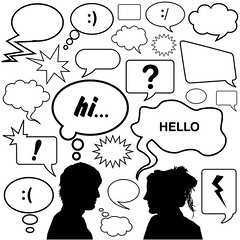
A good way to draw your reader deeply into your story is to use a variety of non-verbal cues in your dialogue. Try the following techniques to dial up your dialogue.
Facial Expressions
When a character raises an eyebrow or furrows his brow, this action gives the reader an additional clue beyond dialogue that indicates a change in the character’s emotional state. As the scene progresses and the emotional intensity rises; the character’s dissatisfaction grows into anger, for instance, the character might clamp his jaw, his nostrils may flare, or eyes narrow to a squint, his face may redden and so on. These are all commonly understood signs of anger.
To learn effective use of these cues, read classic works containing emotional encounters or watch good dramatic films with the sound turned off. Study the facial expressions of the actors and take notes of how they signal emotion.
Talking With Their Hands
Characters can point or jab to intimidate, steeple their fingers during thoughtful reflection, clench their hands into fists or pound a table in anger. Crossing their arms in front of their chests indicates resistance, throwing up their hands in resignation or despair (this gesture is often overused) or holding their hands up to surrender. Rubbing the temple or forehead with their fingers often accompanies stressful thoughts, and pounding a thigh self-recrimination.
Use Movement
One character may cross the room, gaze out a window or push back from a table to get physical and emotional distance from a heated conversation or intimate moment with another character. Moving in closer they can become more threatening or intimate, or drive a point home by occupying the others entire scope of attention.
If a character puts a piece of furniture or some other object between himself and another character, that’s a clear cue that he’s blocking the other character; emotionally, physically or intellectually. Use movement to support and enhance your dialogue, and the scene will be rendered more clearly in your readers mind.
Displays of Emotion
Depending on your character’s personality don’t be afraid to have him take big actions—throw a fit, throw an object, or throw a punch. If your character has a hair-trigger temper, bypass eyebrow raising and go straight to breaking the furniture. If more reserved, use the cues to indicate a slow build-up of anger, passion, fear, hopelessness or joy.
The actions you choose must be consistent with your character’s traits. Every cue action should reflect the character’s personality and emotions, and clarify the scene. Even if your character rarely shows emotion, using small details to show his true feelings leaking out: a tightening around his eyes, a tight grip on a pen, deliberate or forceful steps as he walks around a room.
Show, Don’t Tell
Avoid using adjectives and adverbs to tell your reader what the character is feeling, describe the character himself. For example; instead of “He turned angrily on her.”, try “He turned on her, anger flashing in his eyes.” Instead of “The amorous man reached for her.”, try “With passion swelling within him, he reached for her.”
Physical cues like these make it easier for your reader to see and feel your character’s emotion, even when their words belie that emotion. Craft your characters’ words with care—and back up the emotions with physical cues to telegraph their true feelings to your reader.


All good tips! There’s nothing worse than trying to read a paragraph which is like a dry list: He said…She walked…He turned…He lifted…
So true! Thanks for dropping by Lisa!
I’ll have to remember these tips when I do NaNoWriMo this year!
I’ve read that Writing Dialogue book by Tom. It’s a good one. Another one I like is Dialogue by Lewis Turco, teaching dialogue through dialogue.
Thanks for your recommendation, Grady. I’ll see if I can’t track that down and add it.
It’s an Elements of Fiction Writing series book. It’s great at showing a lot of different aspects of dialogue.
What a fascinating concept! It really makes sense, thinking back to books I’ve read… you can really get a feeling of someone facial expressions, etc… I’m going to have to do some research on this topic. Thanks for sharing!
Actions speak louder than words, as they say. And it’s true, you can say things but with the wrong expressions the listeners might not get your message or worse, get a different meaning out of it. These are such great tips, Allan. Thank you!
I LOVE the recommendation of watching dramatic movies without the sound. What a genius idea! (My roommates are going to think I’m nuts, but I think they have an inkling already.) 🙂
Thank you so much for sharing and for giving the best examples of “Show, don’t tell” I’ve seen so far.
Thanks, Vikki. I used to hang out with a deaf girl who taught me quite a lot about reading peoples faces by ignoring their voices.